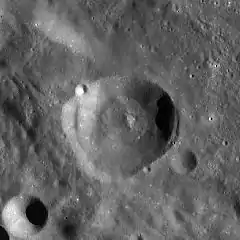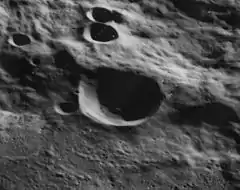 LRO WAC image | |
| Coordinates | 11°24′S 112°36′W / 11.4°S 112.6°W |
|---|---|
| Diameter | 23 km |
| Depth | Unknown |
| Colongitude | 113° at sunrise |
| Eponym | William M. Kearons (es) |

Kearons is a small lunar impact crater that is located on the far side of the Moon, to the northwest of the Mare Orientale impact basin, in the outer skirt of ejecta that surrounds the Montes Cordillera range. It is a relatively isolated crater, possibly because any nearby features have been buried under the ejecta. Some distance to the south is the crater Lewis, and to the north-northeast lies Grachev.
The rim of this crater forms a rounded polygon, with a sharp edge that has a small craterlet across the northwestern side. The inner wall and interior floor are relatively featureless. About a crater diameter to the southwest of Kearons is a smaller crater that has a modest ray system, with rays extending to the north, south, and southwest for up to 100 km.
This crater is named after William M. Kearons (1878-August 13, 1948), an American amateur astronomer who was notable for his photographs of the Sun. He was a minister at the Saint Lukes Episcopal Church in Fall River, Massachusetts.
Satellite craters
By convention these features are identified on lunar maps by placing the letter on the side of the crater midpoint that is closest to Kearons.
| Kearons | Latitude | Longitude | Diameter |
|---|---|---|---|
| U | 10.5° S | 115.9° W | 13 km |
References
- Andersson, L. E.; Whitaker, E. A. (1982). NASA Catalogue of Lunar Nomenclature. NASA RP-1097.
- Blue, Jennifer (July 25, 2007). "Gazetteer of Planetary Nomenclature". USGS. Retrieved 2007-08-05.
- Bussey, B.; Spudis, P. (2004). The Clementine Atlas of the Moon. New York: Cambridge University Press. ISBN 978-0-521-81528-4.
- Cocks, Elijah E.; Cocks, Josiah C. (1995). Who's Who on the Moon: A Biographical Dictionary of Lunar Nomenclature. Tudor Publishers. ISBN 978-0-936389-27-1.
- McDowell, Jonathan (July 15, 2007). "Lunar Nomenclature". Jonathan's Space Report. Retrieved 2007-10-24.
- Menzel, D. H.; Minnaert, M.; Levin, B.; Dollfus, A.; Bell, B. (1971). "Report on Lunar Nomenclature by the Working Group of Commission 17 of the IAU". Space Science Reviews. 12 (2): 136–186. Bibcode:1971SSRv...12..136M. doi:10.1007/BF00171763. S2CID 122125855.
- Moore, Patrick (2001). On the Moon. Sterling Publishing Co. ISBN 978-0-304-35469-6.
- Price, Fred W. (1988). The Moon Observer's Handbook. Cambridge University Press. ISBN 978-0-521-33500-3.
- Rükl, Antonín (1990). Atlas of the Moon. Kalmbach Books. ISBN 978-0-913135-17-4.
- Webb, Rev. T. W. (1962). Celestial Objects for Common Telescopes (6th revised ed.). Dover. ISBN 978-0-486-20917-3.
- Whitaker, Ewen A. (1999). Mapping and Naming the Moon. Cambridge University Press. ISBN 978-0-521-62248-6.
- Wlasuk, Peter T. (2000). Observing the Moon. Springer. ISBN 978-1-85233-193-1.